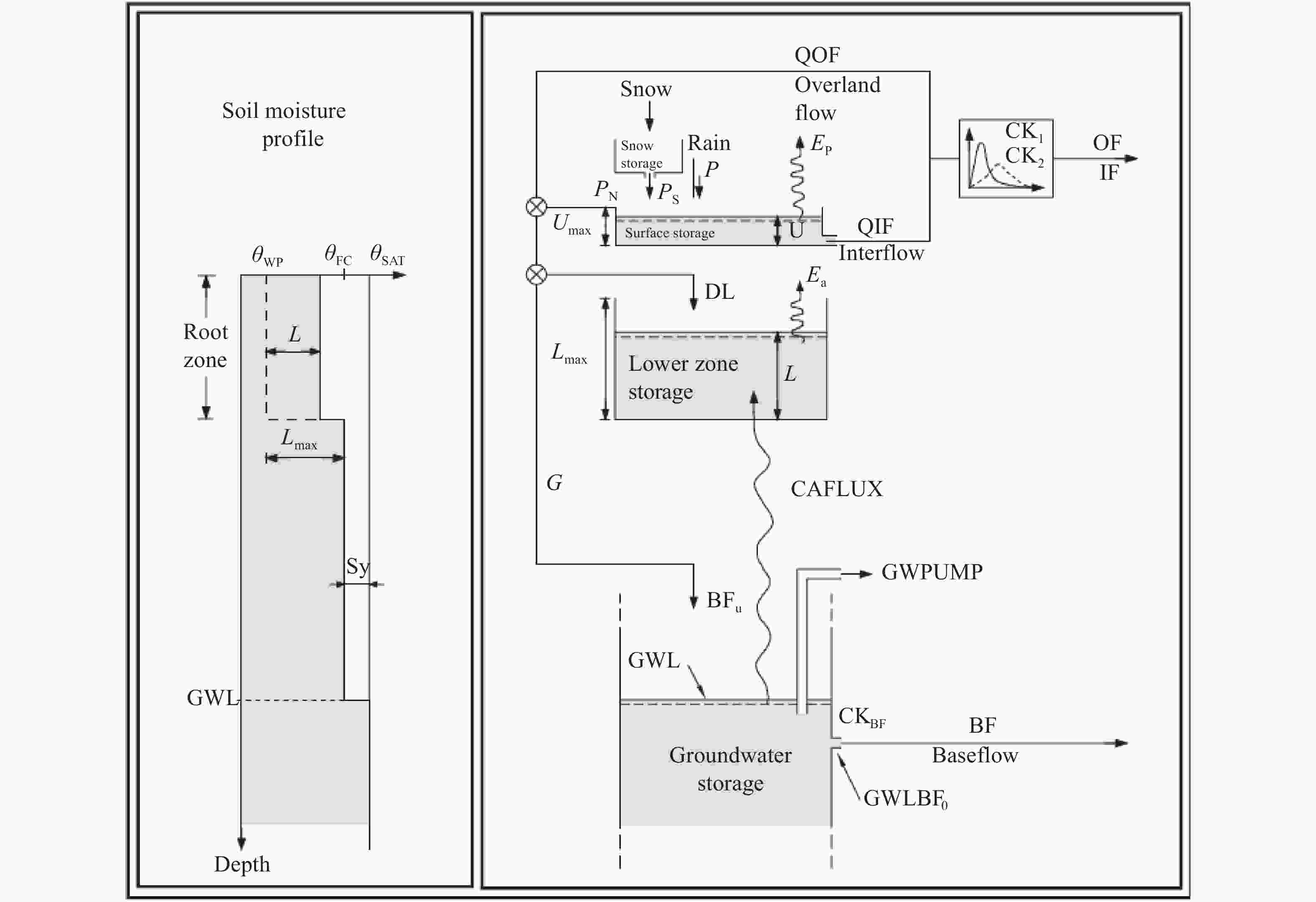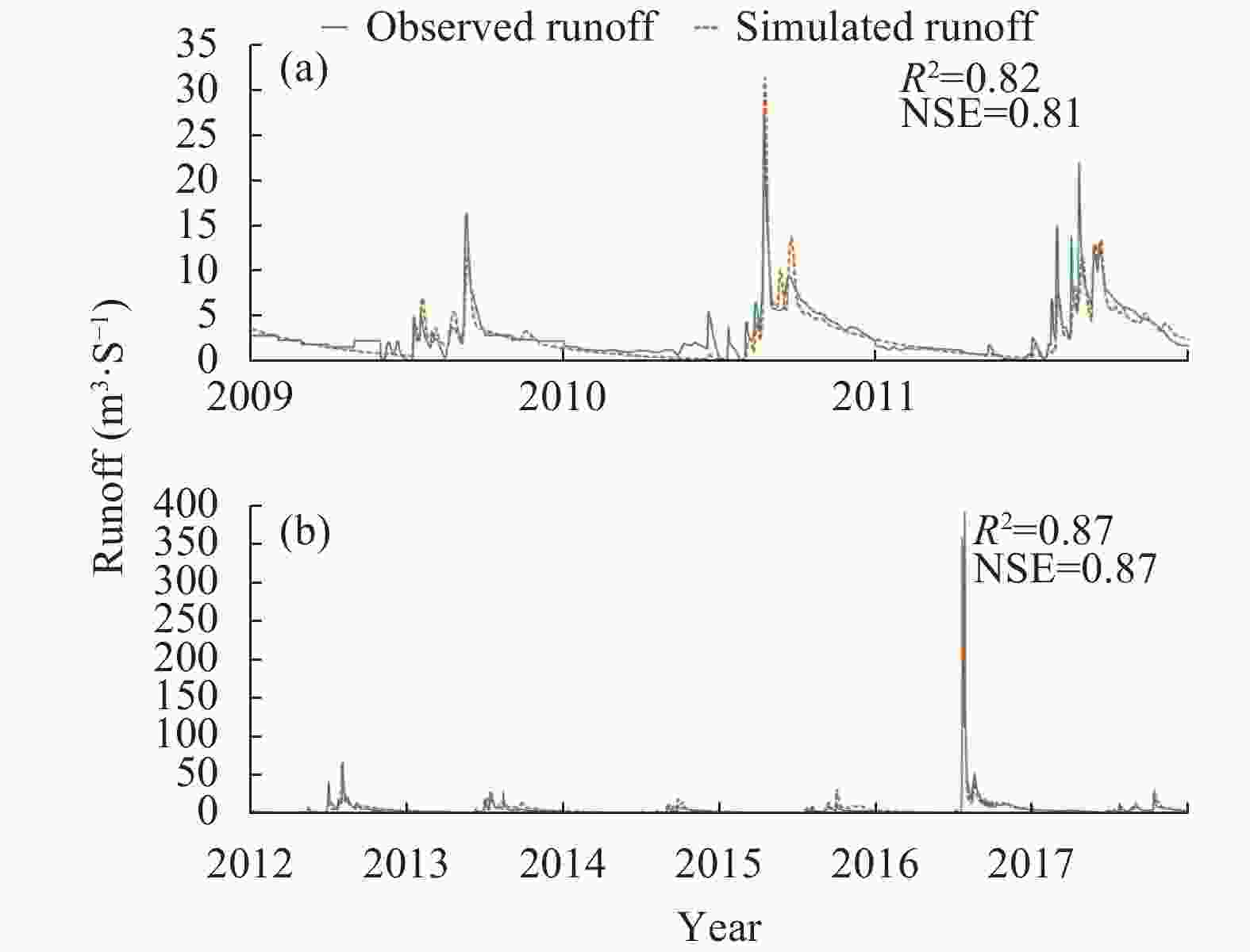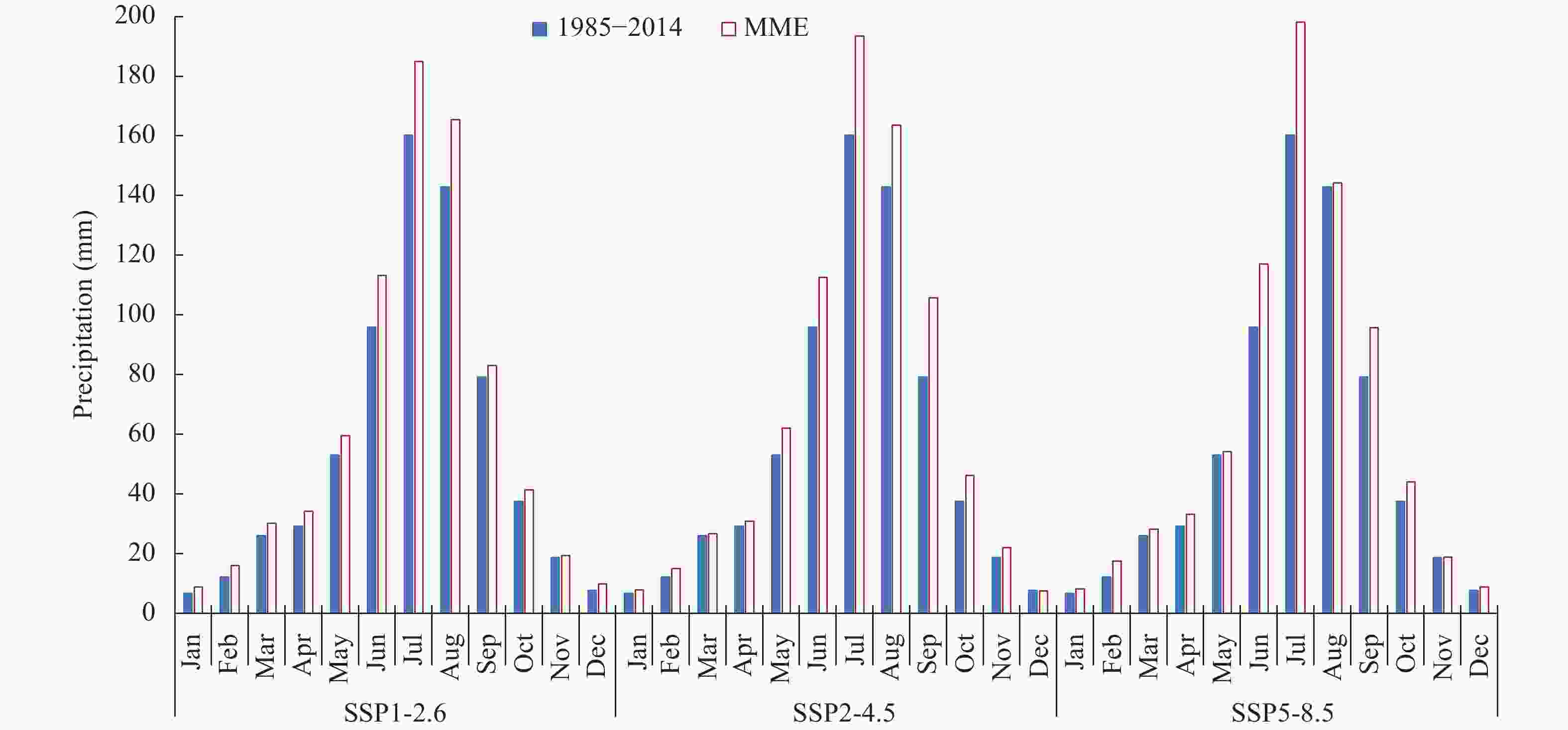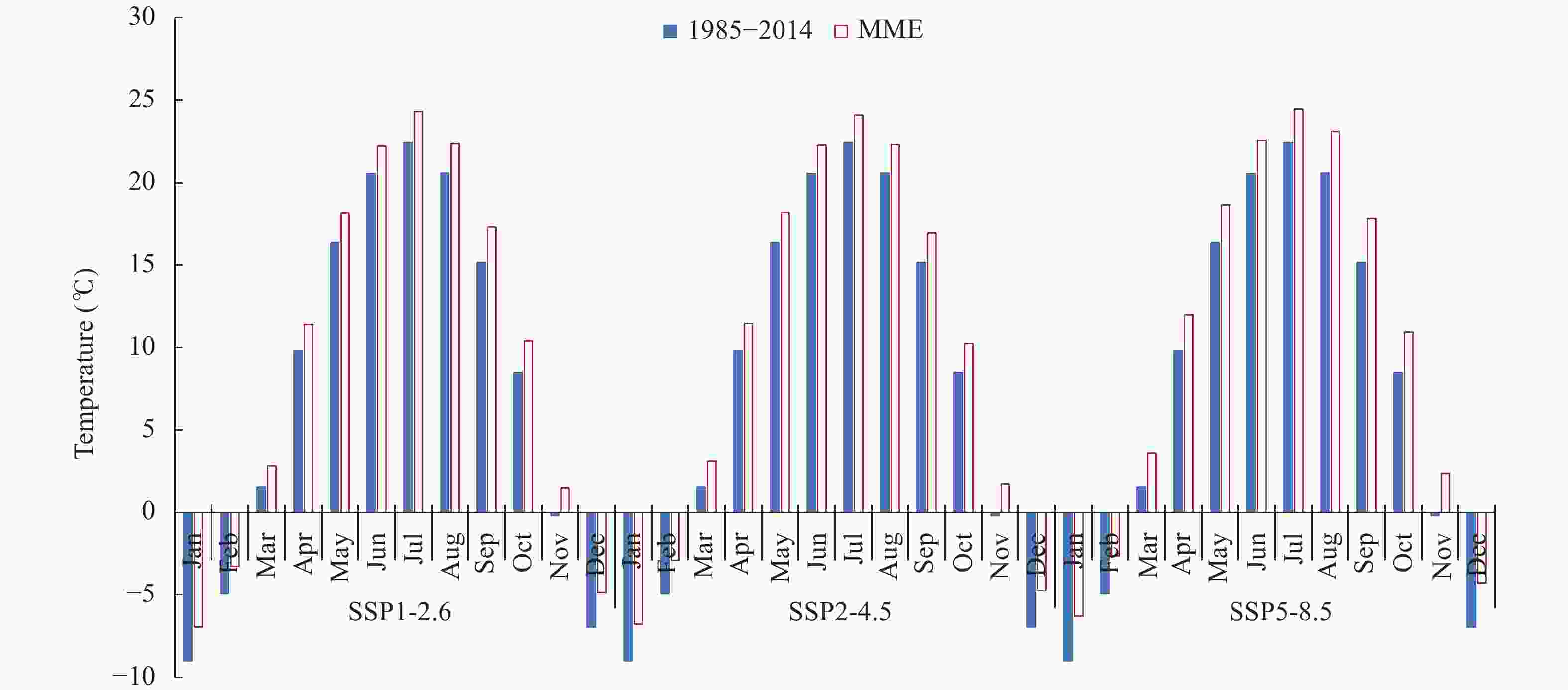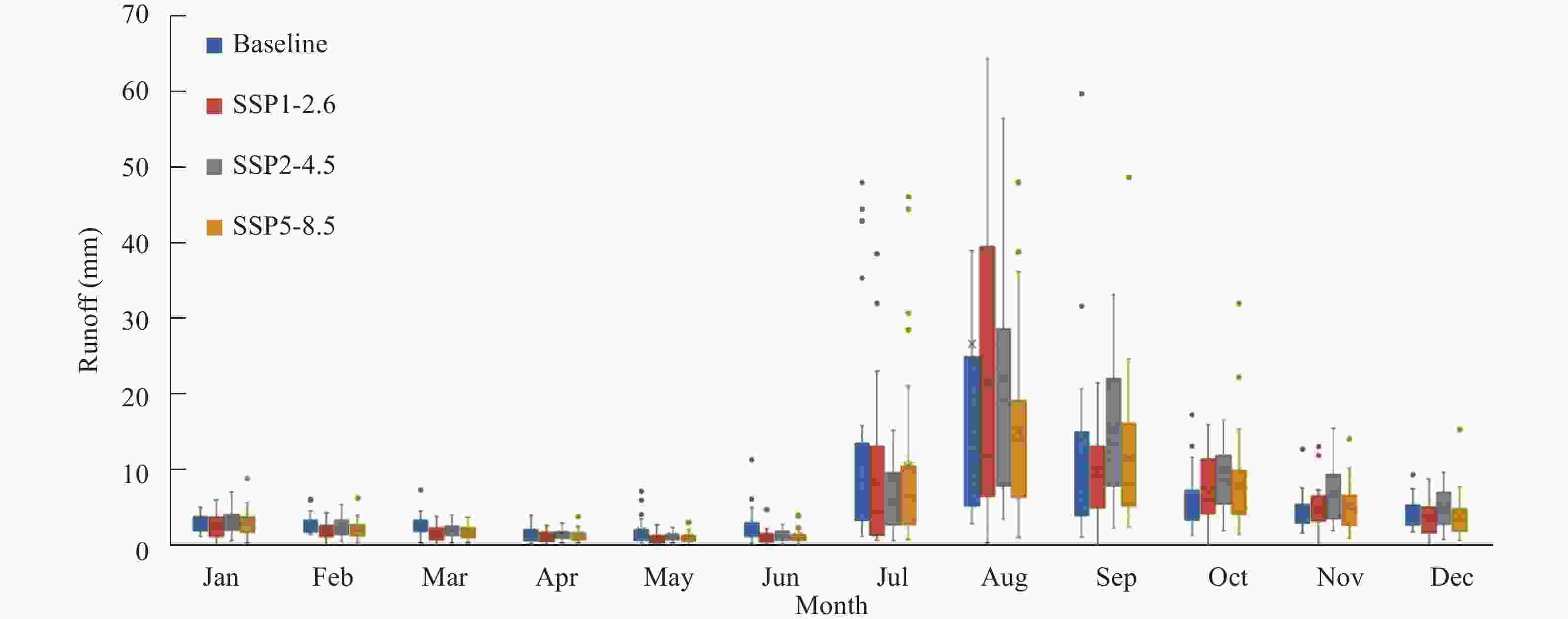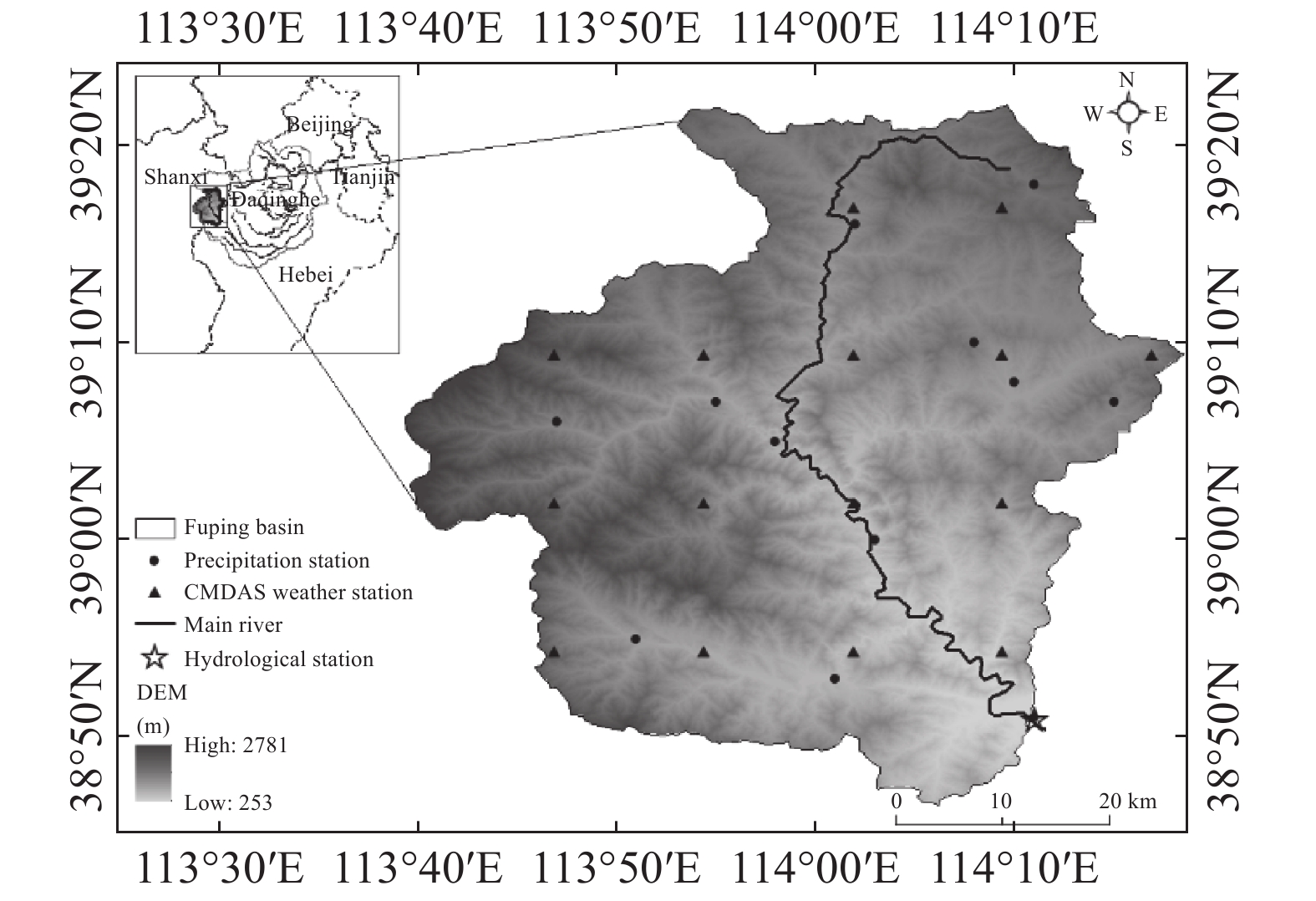Runoff conditions in the Fuping Basin under an ensemble of climate change scenarios
-
摘要: 径流变化对于水资源管理至关重要, 然而, 未来气候变化对阜平流域径流的影响仍未知。本文基于实测数据及4个区域气候模式(RCMs)的集合数据, 使用MIKE11-NAM模型模拟了阜平流域(大清河流域上游的子流域)当前(2008—2017年)及在SSP1-2.6、SSP2-4.5和SSP5-8.5 3种情景下的未来(2025—2054年)径流变化情况。结果表明, MIKE11-NAM模型在日径流模拟中表现良好, R²和NSE在校准期分别为0.82和0.81, 在验证期分别为0.87和0.87。偏差校正后, 观测数据和RCM数据间的相关性提高。与基准期(1985—2014年)相比, 未来的降水量和气温均呈现增加趋势。在SSP5-8.5和SSP2-4.5情景下, 年均温和降水量将分别增加2.45 ℃和124 mm。预计夏季降水量增加幅度较大, 特别是在7—8月; 而各季节的气温将上升, 其中冬季气温上升幅度最大。在SSP2-4.5情景下, 预计年径流量将增加3.5 mm; 而在SSP1-2.6和SSP5-8.5情景下, 预计年径流量将分别减少12.0 mm和11.0 mm。季节尺度上, 在SSP1-2.6、SSP2-4.5和SSP5-8.5情景下, 未来春季径流量将分别减少2.3 mm、1.2 mm和1.9 mm, 夏季径流量将分别减少9.0 mm、7.1 mm和12.9 mm。研究结果可为该地区水资源综合管理和规划提供科学参考。
-
关键词:
- MIKE11-NAM /
- 大清河流域 /
- 模拟 /
- 径流 /
- 气候变化
Abstract: Changes in runoff are of great significance for water resources management, especially under the changing climate. In the Fuping Basin, one of the basins in the upper reaches of the Daqinghe Basin, the water resources are facing changes which show great importance of further studies on runoff conditions in the future in this basin. Hence, in this paper, MIKE11-NAM model was applied to simulate daily runoff (2008−2017) and future runoff conditions under a changing climate in the near future (2025−2054) in the Fuping Basin. After bias correction, an ensemble of four regional climate models (RCMs) was used to develop future climate data under three shared socio-economic pathways (SSP1-2.6, SSP2-4.5, and SSP5-8.5) scenarios. The obtained results showed a good performance of the MIKE11-NAM model in simulating daily runoff. R2 and Nash-Sutcliffe efficiency coefficient (NSE) were 0.82 and 0.81 for calibration, 0.87 and 0.87 for validation, respectively. Although uncertainties remain, the correlation between observed and simulated RCM data was improved after bias correction for all models. Precipitation and temperature were projected to increase under all scenarios compared to the baseline period (1985−2014). Annual temperature and precipitation will increase by 2.45 ℃ and 124 mm under the SSP5-8.5 and SSP2-4.5 scenarios, respectively. However, precipitation is expected to mainly increase in summer while temperature will increase in all the seasons. The projected annual runoff will increase under SSP2-4.5 while decreasing under SSP1-2.6 and SSP5-8.5 scenarios. Seasonally, the future runoff will decrease during spring and summer under all the scenarios. Generally, the changes in runoff conditions will be more obvious in the future. Our findings can be important for integrated water resources management and planning in this region.-
Key words:
- MIKE11-NAM /
- Daqinghe Basin /
- Simulation /
- Runoff /
- Climate change
-
Figure 2.
MIKE11-NAM structure (DHI, 2009) QOF: overland flow; QIF: interflow; GWPUMP: groundwater pumping; GWL: maximum groundwater depth; CAFLUX: capillar flux; Sy: specific yield; BF: baseflow.
Table 1. Parameters used in the MIKE11-NAM model during simulation
Parameter Description Value range Final value Umax (mm) Maximum water content in the surface storage 10−20 12.3 Lmax (mm) Maximum water content in root zone storage 50−300 50.5 CQOF Overland flow runoff coefficient 0−1 0.894 CKIF (h) Time constant for routing interflow 200−1000 449.4 CK1,2 (h) Time constant for routing overland flow 3−48 40.5 TOF Root zone threshold value for overland flow 0−0.99 0.685 TIF Root zone threshold value for interflow 0−0.99 0.0121 TG Root zone threshold value for groundwater recharge 0−0.99 0.154 CKBF (h) Time constant for routing base flow 1−5000 2761 Table 2. Trends of temperature, precipitation and runoff from 1980 to 2017 in the Fuping Basin based on the Mann-Kendall test
Time Temperature Precipitation Runoff ℃∙decade−1 P-value mm∙decade−1 P-value mm∙decade−1 P-value Annual 0.4 <0.001 8.0 0.33 −2.2 0.36 Spring 0.6 <0.001 −3.0 0.30 0.4 0.29 Summer 0.3 <0.05 −2.4 0.38 −3.0 0.19 Autumn 0.3 <0.05 17.5 <0.001 0.8 0.34 Winter 0.7 <0.001 1.0 0.09 −0.3 0.32 Table 3. Bias correction performance of four regional climate models for monthly precipitation and temperature estimation compared to the observed data
Variable Model Before correction After correction R2 RMSE R2 RMSE Temperature ACCESS_ESM1_5 0.97 2.18 ℃ 0.97 1.83 Can_ESM5 0.95 4.30 ℃ 0.95 2.40 EC_EARTH3 0.95 2.69 ℃ 0.96 2.27 MPI_ESM1_2HR 0.96 2.17 ℃ 0.97 2.05 Precipitation ACCESS_ESM1_5 0.43 50.71 mm 0.43 49.00 Can_ESM5 0.35 51.45 mm 0.45 49.73 EC_EARTH3 0.46 50.15 mm 0.47 48.62 MPI_ESM1_2HR 0.41 50.51 mm 0.47 49.85 Table 4. Precipitation and temperature change comparison between historical observed data (1985−2014) and future data (2025−2054) based on four regional climate models (RCM) and multimodel ensemble under 3 scenarios
Variable Scenario Historical
(1985−2014)RCM model (2025−2054) Multi-model
ensemble (MME)ACCESS-ESMI-5 Can-ESM5 EC-Earth3 MPI-ESMI-2HR Temperature (℃) SSP1-2.6 7.8 +1.96 +2.06 +2.54 +0.93 +1.87 SSP2-4.5 +1.97 +2.43 +2.44 +0.83 +1.92 SSP5-8.5 +2.52 +2.97 +2.92 +1.37 +2.45 Precipitation (mm) SSP1-2.6 670 +72 +142 +104 +70 +97 SSP2-4.5 +99 +187 +121 +89 +124 SSP5-8.5 +23 +194 +129 +51 +99 “+” means the increase. -
[1] ALLEN R G, PEREIRA L S, RAES D, et al. 1988. Crop evapotranspiration - Guidelines for computing crop water requirements-FAO Irrigation and drainage paper 56[M]. Rome: Food and Agriculture Organization of United Nations [2] AMIR M S I I, KHAN M M K, RASUL M G, et al. 2013. Automatic multi-objective calibration of a rainfall runoff model for the fitzroy basin, Queensland, Australia[J]. International Journal of Environmental Science and Development: 311−315 doi: 10.7763/IJESD.2013.V4.361 [3] BAO Z X, ZHANG J Y, YAN X L, et al. 2020. Future streamflow assessment in the Haihe River Basin located in northern China using a regionalized variable infiltration capacity model based on 18 CMIP5 GCMs[J]. Journal of Water and Climate Change, 11(4): 1551−1569 doi: 10.2166/wcc.2019.095 [4] CHEN F, HE X, WANG W. 2011. Impacts of precipitation changes and human activities on runoff of Fuping Basin[J]. Yellow River, 33(10): 28−30, 53 [5] DHI. 2009. MIKE 11- A Modelling System for Rivers and Channels. Reference Manual[M]. DHI: 1422–1432 [6] DOULGERIS C, GEORGIOU P, PAPADIMOS D, et al. 2012. Ecosystem approach to water resources management using the MIKE 11 modeling system in the Strymonas River and Lake Kerkini[J]. Journal of Environmental Management, 94(1): 132−143 [7] FENG P, WU J Z, LI J Z. 2019. Changes in flood characteristics and the flood driving mechanism in the mountainous Haihe River Basin, China[J]. Hydrological Sciences Journal, 64(16): 1997−2005 doi: 10.1080/02626667.2019.1619931 [8] FILIANOTI P, GURNARI L, ZEMA D A, et al. 2020. An evaluation matrix to compare computer hydrological models for flood predictions[J]. Hydrology, 7(3): 42 doi: 10.3390/hydrology7030042 [9] GAO X P, LYU M C, LIU Y Z, et al. 2022. Precipitation projection over Daqing River Basin (North China) considering the evolution of dependence structures[J]. Environmental Science and Pollution Research, 29(4): 5415−5430 doi: 10.1007/s11356-021-16066-9 [10] GAO Y C, WANG J F, FENG Z M. 2017. Variation trend and response relationship of temperature, precipitation and runoff in Baiyangdian Lake Basin[J]. Chinese Journal of Eco-Agriculture, 25(4): 467−477 [11] GU H H, YU Z B, YANG C G, et al. 2018. High-resolution ensemble projections and uncertainty assessment of regional climate change over China in CORDEX East Asia[J]. Hydrology and Earth System Sciences, 22(5): 3087−3103 doi: 10.5194/hess-22-3087-2018 [12] GUAN X X, ZHANG J Y, BAO Z X, et al. 2021. Past variations and future projection of runoff in typical basins in 10 water zones, China[J]. The Science of the Total Environment, 798: 149277 doi: 10.1016/j.scitotenv.2021.149277 [13] HAFEZPARAST M. 2015. Comparing the subjective and the objective criteria weighting in agricultural water resources management[J]. Hydrology, 3(4): 38 doi: 10.11648/j.hyd.20150304.11 [14] ISLAM S U, CURRY C L, DÉRY S J, et al. 2019. Quantifying projected changes in runoff variability and flow regimes of the Fraser River Basin, British Columbia[J]. Hydrology and Earth System Sciences, 23(2): 811−828 doi: 10.5194/hess-23-811-2019 [15] JIANG Y. 2009. China’s water scarcity[J]. Journal of Environmental Management, 90(11): 3185−3196 doi: 10.1016/j.jenvman.2009.04.016 [16] JIAO Y F, LIU J, LI C Z, et al. 2021. Evolution of meteorological factors during 1980–2015 in the Daqing River Basin, North China[J]. Journal of Water and Climate Change, 12(7): 2977−2992 doi: 10.2166/wcc.2021.205 [17] JOYNES A. 2009. Effects of land use change in the Waikato River catchment between Karapiro and Taupo hydrological & hydraulic modelling of the Waikato and Waipa Catchments North of Karapiro Dam[D]. 121 [18] KESKIN F, ŞENSOY A, ŞORMAN A. 2008. Application of MIKE11 model for the simulation of snowmelt runoff in Yuvacik dam basin, Turkey[J]. International Congress on River Basin Management: 472−484 [19] KNOBEN W J M, FREER J E, WOODS R A. 2019. Technical note: inherent benchmark or not? Comparing Nash-Sutcliffe and Kling-Gupta efficiency scores[J]. Hydrology and Earth System Sciences, 23(10): 4323−4331 doi: 10.5194/hess-23-4323-2019 [20] LI J Z, FENG P, CHEN F L. 2014. Effects of land use change on flood characteristics in mountainous area of Daqinghe watershed, China[J]. Natural Hazards, 70(1): 593−607 doi: 10.1007/s11069-013-0830-8 [21] LI J Z, FENG P, WEI Z Z. 2013. Incorporating the data of different watersheds to estimate the effects of land use change on flood peak and volume using multi-linear regression[J]. Mitigation and Adaptation Strategies for Global Change, 18(8): 1183−1196 doi: 10.1007/s11027-012-9416-0 [22] LI R N, ZHENG H, HUANG B B, et al. 2018. Dynamic impacts of climate and land-use changes on surface runoff in the mountainous region of the Haihe River Basin, China[J]. Advances in Meteorology, 2018: 3287343 [23] LIU L L, DU J J. 2017. Documented changes in annual runoff and attribution since the 1950s within selected rivers in China[J]. Advances in Climate Change Research, 8(1): 37−47 doi: 10.1016/j.accre.2017.03.005 [24] LIU Q, YAN S R, LI M, et al. 2021. Baseflow separation and its response to meteorological drought in a temperate water-limited basin, North China[J]. Chinese Geographical Science, 31(5): 867−876 doi: 10.1007/s11769-021-1231-7 [25] LIU W. 2020. Analysis of runoff characteristics of typical stations in Shahe River Basin[J]. Science and Technology Innovation, (12): 40−41 [26] LUO M, LIU T, MENG F H, et al. 2019. Identifying climate change impacts on water resources in Xinjiang, China[J]. The Science of the Total Environment, 676: 613−626 doi: 10.1016/j.scitotenv.2019.04.297 [27] LUO M, LIU T, MENG F H, et al. 2018. Comparing bias correction methods used in downscaling precipitation and temperature from regional climate models: a case study from the kaidu river basin in western China[J]. Water, 10(8): 1046 doi: 10.3390/w10081046 [28] MADSEN H. 2000. Automatic calibration of a conceptual rainfall-runoff model using multiple objectives[J]. Journal of Hydrology, 235(3/4): 276−288 [29] MAKUNGO R, ODIYO J O, NDIRITU J G, et al. 2010. Rainfall-runoff modelling approach for ungauged catchments: a case study of Nzhelele River sub-quaternary catchment[J]. Physics and Chemistry of the Earth, Parts A/B/C, 35(13/14): 596−607 [30] MOLINI A, KATUL G G, PORPORATO A. 2011. Maximum discharge from snowmelt in a changing climate[J]. Geophysical Research Letters, 38(5): 1−5 doi: 10.1029/2010GL046477 [31] NASH J, SUTCLIFFE J. 1970. River flow forecasting through conceptual models part Ⅰ — a discussion of principles[J]. Journal of Hydrology, 10: 282−290 doi: 10.1016/0022-1694(70)90255-6 [32] ODIYO J O, PHANGISA J I, MAKUNGO R. 2012. Rainfall-runoff modelling for estimating Latonyanda River flow contributions to Luvuvhu River downstream of Albasini Dam[J]. Physics and Chemistry of the Earth, Parts A/B/C, 50/51/52: 5−13 [33] RAO X Q, LU X, DONG W J. 2019. Evaluation and projection of extreme precipitation over northern China in CMIP5 models[J]. Atmosphere, 10(11): 691 doi: 10.3390/atmos10110691 [34] SHEN Y J, SHEN Y J, FINK M, et al. 2018. Trends and variability in streamflow and snowmelt runoff timing in the southern Tianshan Mountains[J]. Journal of Hydrology, 557: 173−181 doi: 10.1016/j.jhydrol.2017.12.035 [35] SHEN Y J, OKI T, UTSUMI N, et al. 2008. Projection of future world water resources under SRES scenarios: water withdrawal[J]. Water and Energy Abstracts, 18(2): 9 [36] SHRESTHA S, IMBULANA N, PIMAN T, et al. 2020. Multimodelling approach to the assessment of climate change impacts on hydrology and river morphology in the Chindwin River Basin, Myanmar[J]. CATENA, 188: 104464 doi: 10.1016/j.catena.2020.104464 [37] TEUTSCHBEIN C, SEIBERT J. 2012. Bias correction of regional climate model simulations for hydrological climate-change impact studies: review and evaluation of different methods[J]. Journal of Hydrology, 456/457: 12−29 doi: 10.1016/j.jhydrol.2012.05.052 [38] TIAN J, ZHANG Z, AHMED Z, et al. 2021. Projections of precipitation over China based on CMIP6 models[J]. Stochastic Environmental Research and Risk Assessment, 35(4): 831−848 [39] TRINH M X, MOLKENTHIN F. 2021. Flood hazard mapping for data-scarce and ungauged coastal river basins using advanced hydrodynamic models, high temporal-spatial resolution remote sensing precipitation data, and satellite imageries[J]. Natural Hazards, 109: 441−469 doi: 10.1007/s11069-021-04843-1 [40] WANG J F, GAO Y C, WANG S. 2018. Assessing the response of runoff to climate change and human activities for a typical basin in the Northern Taihang Mountain, China[J]. Journal of Earth System Science, 127(3): 1−15 [41] WANG L Y, LI Y K, ZHENG H, et al. 2012. Evaluating the effects of climate changes and LUCC on the hydrological processes using soil and water assessment tool models in Wangkuai Reservoir watershed in China[J]. Sensor Letters, 10(1): 405−414 doi: 10.1166/sl.2012.1853 [42] WANG Y J, YANG G, GU X C, et al. 2021. Application of SWAT model with CMADS data for hydrological simulation in western China[J]. Journal of Water and Climate Change, 12(4): 1154−1167 doi: 10.2166/wcc.2020.040 [43] XIA J, DUAN Q Y, LUO Y, et al. 2017. Climate change and water resources: case study of eastern monsoon region of China[J]. Advances in Climate Change Research, 8(2): 63−67 doi: 10.1016/j.accre.2017.03.007 [44] XING W Q, WANG W G, ZOU S, et al. 2018. Projection of future runoff change using climate elasticity method derived from Budyko framework in major basins across China[J]. Global and Planetary Change, 162: 120−135 doi: 10.1016/j.gloplacha.2018.01.006 [45] XU H S, REN Y F, ZHENG H, et al. 2020. Analysis of runoff trends and drivers in the Haihe River Basin, China[J]. International Journal of Environmental Research and Public Health, 17(5): 1577 doi: 10.3390/ijerph17051577 [46] XU X Y, YANG D W, YANG H B, et al. 2014. Attribution analysis based on the Budyko hypothesis for detecting the dominant cause of runoff decline in Haihe Basin[J]. Journal of Hydrology, 510: 530−540 doi: 10.1016/j.jhydrol.2013.12.052 [47] YANG X L, ZHOU B T, XU Y, et al. 2021. CMIP6 evaluation and projection of temperature and precipitation over China[J]. Advances in Atmospheric Sciences, 38(5): 817−830 doi: 10.1007/s00376-021-0351-4 [48] YANG Y, YANG Z F, YIN X A, et al. 2018. A framework for assessing flow regime alterations resulting from the effects of climate change and human disturbance[J]. Hydrological Sciences Journal, 63(3): 441−456 doi: 10.1080/02626667.2018.1430897 [49] ZHANG G W, ZENG G, YANG X Y, et al. 2021b. Future changes in extreme high temperature over China at 1.5 ℃–5 ℃ global warming based on CMIP6 simulations[J]. Advances in Atmospheric Sciences, 38(2): 253−267 doi: 10.1007/s00376-020-0182-8 [50] ZHANG J P, ZHANG H, XIAO H L, et al. 2021a. Effects of rainfall and runoff-yield conditions on runoff[J]. Ain Shams Engineering Journal, 12(2): 2111−2116 doi: 10.1016/j.asej.2020.10.010 [51] ZHAO F B, WU Y P, QIU L J, et al. 2018. Parameter uncertainty analysis of the SWAT model in a mountain-loess transitional watershed on the Chinese loess plateau[J]. Water, 10(6): 690 doi: 10.3390/w10060690 [52] ZHOU W, LYU A F, JIA S F. 2011. Trends and causes of runoff changes in mountainous areas of the Baiyangdian Lake Basin during the reriod 1959−2008[J]. Resource Science: 1249−1255 -





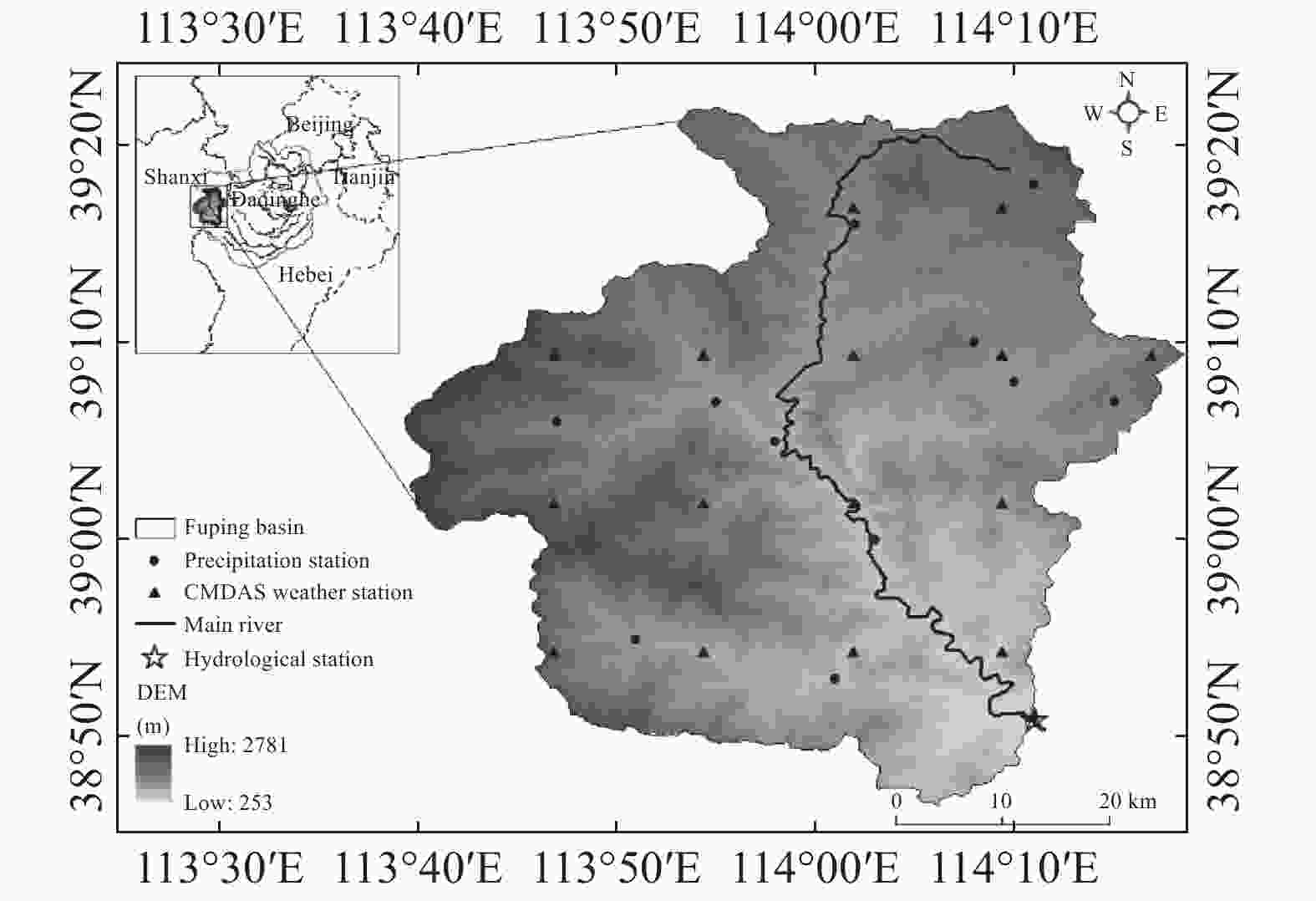
 下载:
下载:
